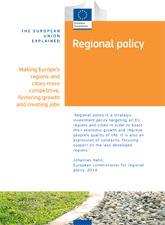
Brochures
Date: 18 sep 2014
Period: 2014-2020
Theme: Business support, Energy, Environment, Transport, Urban development, Research and innnovation, Research & Development, Social inclusion, Jobs, Education and Training
Languages: bg | cs | da | de | el | en | es | et | fi | fr | hr | hu | it | lt | lv | mt | nl | pl | pt | ro | sk | sl | sv
EU regional policy accounts for the single largest chunk of the EU budget for 2014–20 (€351.8 billion out of a total €1 082 billion) and is therefore the Union’s main investment arm.
These resources are used to finance strategic transport and communication infrastructures, to favour a transition to a more environmentally friendly economy, to support small and medium-sized enterprises (SMEs) in becoming more innovative and more competitive, to create new and lasting job opportunities, to reinforce and modernise education systems and to build a more inclusive society.
In so doing, regional policy serves as a catalyst for further public and private funding, not only because it obliges EU countries to co-finance projects from their respective national budgets but also because it creates investor confidence. Taking into account this national contribution, and the leverage effect of financial instruments, the overall impact of EU investment for 2014–20 is likely to be more than €500 billion.
